Developing Business Case for Nettavisen Online Newspaper - MIS782
VerifiedAdded on 2023/04/21
|28
|6352
|286
Case Study
AI Summary
This assignment presents a comprehensive business case analysis of Nettavisen, a Norwegian online newspaper. The student explores the company's business problems and opportunities, particularly in the context of a rapidly evolving online news market. The analysis includes a discussion of business and IT alignment, identifying key challenges related to data volume, variety, veracity, variability, and value. The assignment then delves into the determination and analysis of alternatives for a data-driven business model (DDBM), including real-time processing frameworks and massively parallel processing platforms. The student evaluates the feasibility, benefits, costs, and risks associated with each alternative, ultimately providing a recommendation and outlining a plan for implementation. The case study highlights the importance of digital transformation and the need for Nettavisen to leverage big data for customer engagement and revenue generation. The analysis emphasizes the need for strategic partnerships, skilled personnel, and a focus on customer-centricity within the retail sector, drawing parallels to the opportunities available to Nettavisen. The assignment concludes with a detailed exploration of IT alignment, offering a framework for positioning Nettavisen within the competitive landscape and identifying potential gaps in its data sources and revenue models.
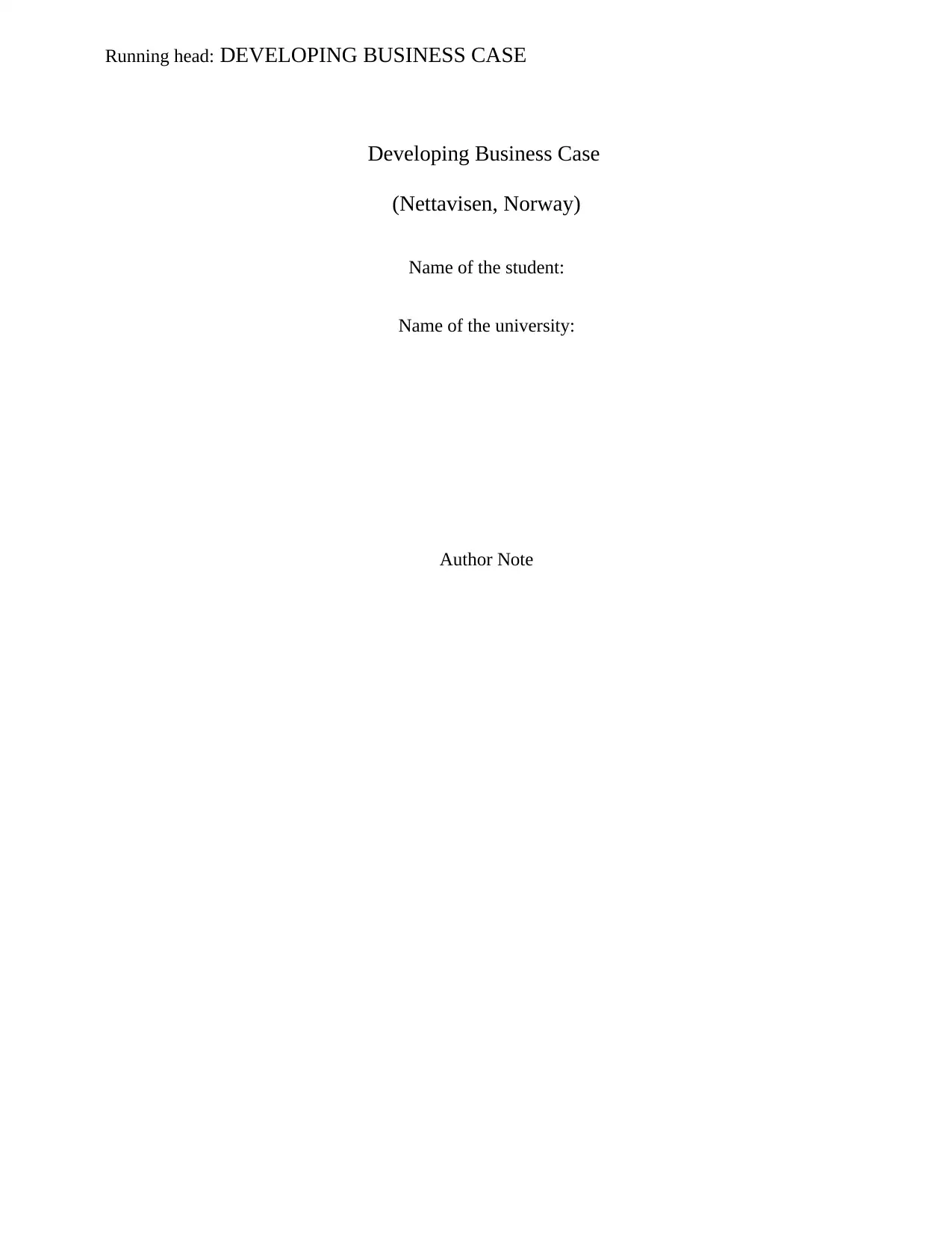
Running head: DEVELOPING BUSINESS CASE
Developing Business Case
(Nettavisen, Norway)
Name of the student:
Name of the university:
Author Note
Developing Business Case
(Nettavisen, Norway)
Name of the student:
Name of the university:
Author Note
Paraphrase This Document
Need a fresh take? Get an instant paraphrase of this document with our AI Paraphraser
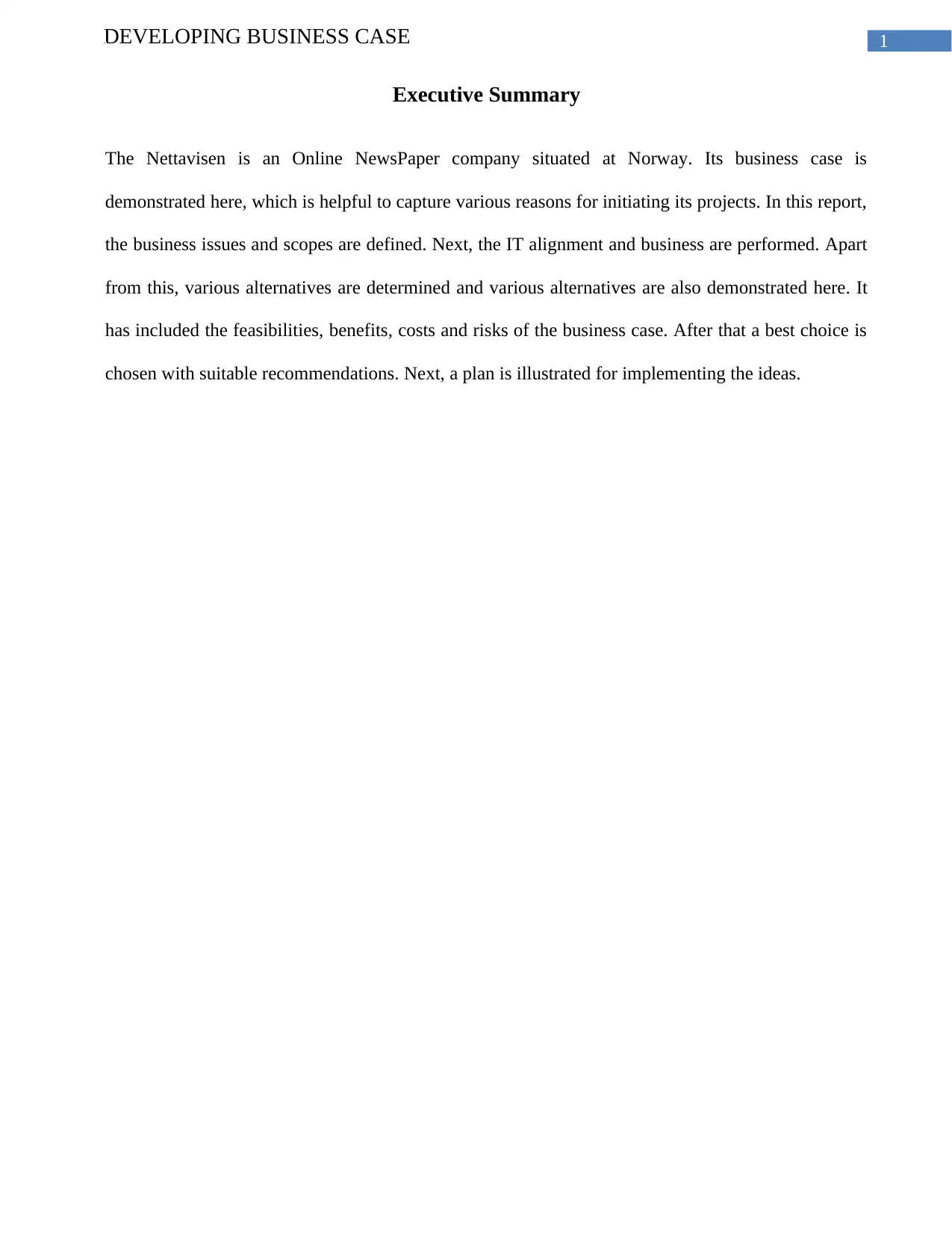
1DEVELOPING BUSINESS CASE
Executive Summary
The Nettavisen is an Online NewsPaper company situated at Norway. Its business case is
demonstrated here, which is helpful to capture various reasons for initiating its projects. In this report,
the business issues and scopes are defined. Next, the IT alignment and business are performed. Apart
from this, various alternatives are determined and various alternatives are also demonstrated here. It
has included the feasibilities, benefits, costs and risks of the business case. After that a best choice is
chosen with suitable recommendations. Next, a plan is illustrated for implementing the ideas.
Executive Summary
The Nettavisen is an Online NewsPaper company situated at Norway. Its business case is
demonstrated here, which is helpful to capture various reasons for initiating its projects. In this report,
the business issues and scopes are defined. Next, the IT alignment and business are performed. Apart
from this, various alternatives are determined and various alternatives are also demonstrated here. It
has included the feasibilities, benefits, costs and risks of the business case. After that a best choice is
chosen with suitable recommendations. Next, a plan is illustrated for implementing the ideas.
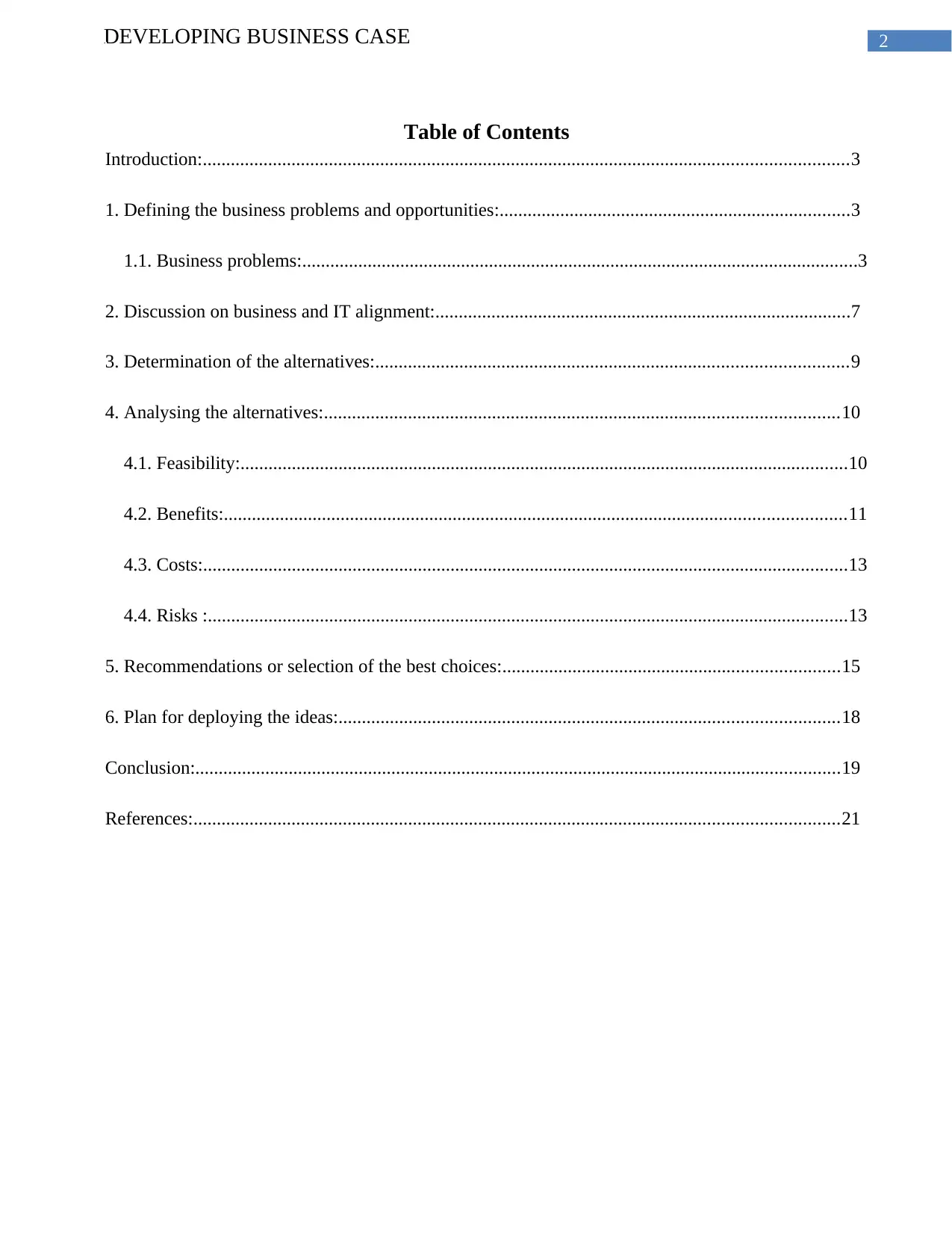
2DEVELOPING BUSINESS CASE
Table of Contents
Introduction:..........................................................................................................................................3
1. Defining the business problems and opportunities:...........................................................................3
1.1. Business problems:.......................................................................................................................3
2. Discussion on business and IT alignment:.........................................................................................7
3. Determination of the alternatives:.....................................................................................................9
4. Analysing the alternatives:..............................................................................................................10
4.1. Feasibility:..................................................................................................................................10
4.2. Benefits:.....................................................................................................................................11
4.3. Costs:..........................................................................................................................................13
4.4. Risks :.........................................................................................................................................13
5. Recommendations or selection of the best choices:........................................................................15
6. Plan for deploying the ideas:...........................................................................................................18
Conclusion:..........................................................................................................................................19
References:..........................................................................................................................................21
Table of Contents
Introduction:..........................................................................................................................................3
1. Defining the business problems and opportunities:...........................................................................3
1.1. Business problems:.......................................................................................................................3
2. Discussion on business and IT alignment:.........................................................................................7
3. Determination of the alternatives:.....................................................................................................9
4. Analysing the alternatives:..............................................................................................................10
4.1. Feasibility:..................................................................................................................................10
4.2. Benefits:.....................................................................................................................................11
4.3. Costs:..........................................................................................................................................13
4.4. Risks :.........................................................................................................................................13
5. Recommendations or selection of the best choices:........................................................................15
6. Plan for deploying the ideas:...........................................................................................................18
Conclusion:..........................................................................................................................................19
References:..........................................................................................................................................21
⊘ This is a preview!⊘
Do you want full access?
Subscribe today to unlock all pages.

Trusted by 1+ million students worldwide
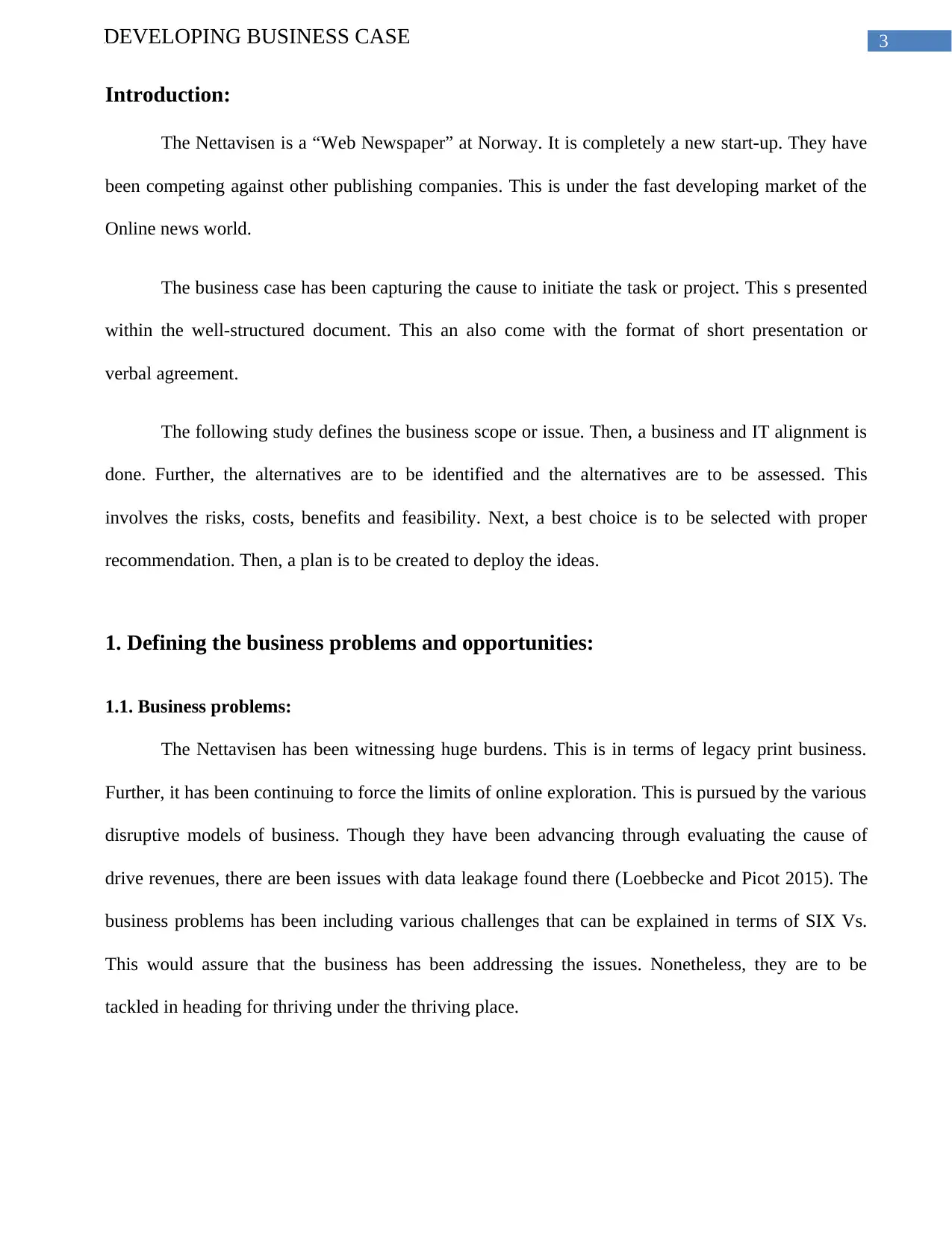
3DEVELOPING BUSINESS CASE
Introduction:
The Nettavisen is a “Web Newspaper” at Norway. It is completely a new start-up. They have
been competing against other publishing companies. This is under the fast developing market of the
Online news world.
The business case has been capturing the cause to initiate the task or project. This s presented
within the well-structured document. This an also come with the format of short presentation or
verbal agreement.
The following study defines the business scope or issue. Then, a business and IT alignment is
done. Further, the alternatives are to be identified and the alternatives are to be assessed. This
involves the risks, costs, benefits and feasibility. Next, a best choice is to be selected with proper
recommendation. Then, a plan is to be created to deploy the ideas.
1. Defining the business problems and opportunities:
1.1. Business problems:
The Nettavisen has been witnessing huge burdens. This is in terms of legacy print business.
Further, it has been continuing to force the limits of online exploration. This is pursued by the various
disruptive models of business. Though they have been advancing through evaluating the cause of
drive revenues, there are been issues with data leakage found there (Loebbecke and Picot 2015). The
business problems has been including various challenges that can be explained in terms of SIX Vs.
This would assure that the business has been addressing the issues. Nonetheless, they are to be
tackled in heading for thriving under the thriving place.
Introduction:
The Nettavisen is a “Web Newspaper” at Norway. It is completely a new start-up. They have
been competing against other publishing companies. This is under the fast developing market of the
Online news world.
The business case has been capturing the cause to initiate the task or project. This s presented
within the well-structured document. This an also come with the format of short presentation or
verbal agreement.
The following study defines the business scope or issue. Then, a business and IT alignment is
done. Further, the alternatives are to be identified and the alternatives are to be assessed. This
involves the risks, costs, benefits and feasibility. Next, a best choice is to be selected with proper
recommendation. Then, a plan is to be created to deploy the ideas.
1. Defining the business problems and opportunities:
1.1. Business problems:
The Nettavisen has been witnessing huge burdens. This is in terms of legacy print business.
Further, it has been continuing to force the limits of online exploration. This is pursued by the various
disruptive models of business. Though they have been advancing through evaluating the cause of
drive revenues, there are been issues with data leakage found there (Loebbecke and Picot 2015). The
business problems has been including various challenges that can be explained in terms of SIX Vs.
This would assure that the business has been addressing the issues. Nonetheless, they are to be
tackled in heading for thriving under the thriving place.
Paraphrase This Document
Need a fresh take? Get an instant paraphrase of this document with our AI Paraphraser
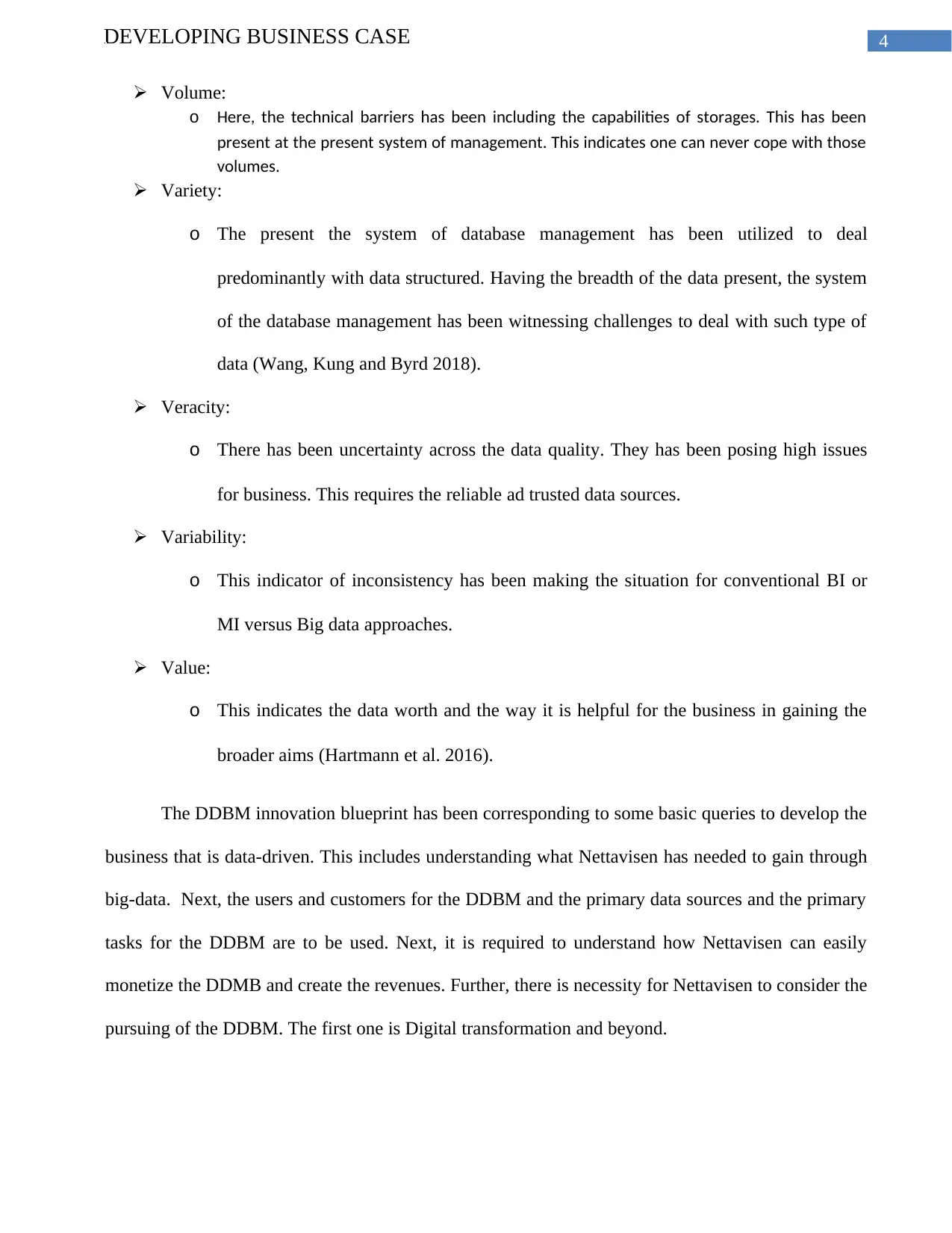
4DEVELOPING BUSINESS CASE
Volume:
o Here, the technical barriers has been including the capabilities of storages. This has been
present at the present system of management. This indicates one can never cope with those
volumes.
Variety:
o The present the system of database management has been utilized to deal
predominantly with data structured. Having the breadth of the data present, the system
of the database management has been witnessing challenges to deal with such type of
data (Wang, Kung and Byrd 2018).
Veracity:
o There has been uncertainty across the data quality. They has been posing high issues
for business. This requires the reliable ad trusted data sources.
Variability:
o This indicator of inconsistency has been making the situation for conventional BI or
MI versus Big data approaches.
Value:
o This indicates the data worth and the way it is helpful for the business in gaining the
broader aims (Hartmann et al. 2016).
The DDBM innovation blueprint has been corresponding to some basic queries to develop the
business that is data-driven. This includes understanding what Nettavisen has needed to gain through
big-data. Next, the users and customers for the DDBM and the primary data sources and the primary
tasks for the DDBM are to be used. Next, it is required to understand how Nettavisen can easily
monetize the DDMB and create the revenues. Further, there is necessity for Nettavisen to consider the
pursuing of the DDBM. The first one is Digital transformation and beyond.
Volume:
o Here, the technical barriers has been including the capabilities of storages. This has been
present at the present system of management. This indicates one can never cope with those
volumes.
Variety:
o The present the system of database management has been utilized to deal
predominantly with data structured. Having the breadth of the data present, the system
of the database management has been witnessing challenges to deal with such type of
data (Wang, Kung and Byrd 2018).
Veracity:
o There has been uncertainty across the data quality. They has been posing high issues
for business. This requires the reliable ad trusted data sources.
Variability:
o This indicator of inconsistency has been making the situation for conventional BI or
MI versus Big data approaches.
Value:
o This indicates the data worth and the way it is helpful for the business in gaining the
broader aims (Hartmann et al. 2016).
The DDBM innovation blueprint has been corresponding to some basic queries to develop the
business that is data-driven. This includes understanding what Nettavisen has needed to gain through
big-data. Next, the users and customers for the DDBM and the primary data sources and the primary
tasks for the DDBM are to be used. Next, it is required to understand how Nettavisen can easily
monetize the DDMB and create the revenues. Further, there is necessity for Nettavisen to consider the
pursuing of the DDBM. The first one is Digital transformation and beyond.
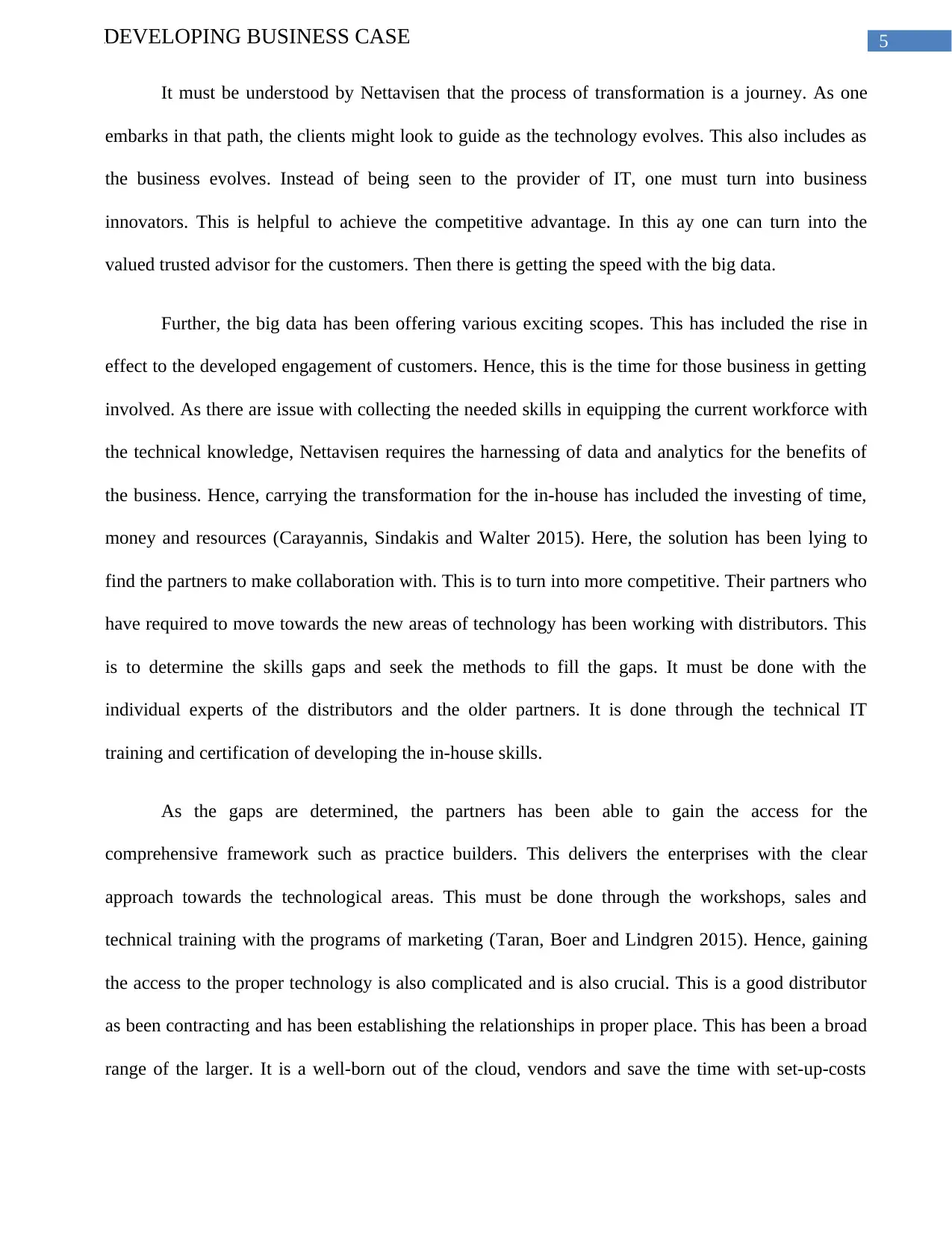
5DEVELOPING BUSINESS CASE
It must be understood by Nettavisen that the process of transformation is a journey. As one
embarks in that path, the clients might look to guide as the technology evolves. This also includes as
the business evolves. Instead of being seen to the provider of IT, one must turn into business
innovators. This is helpful to achieve the competitive advantage. In this ay one can turn into the
valued trusted advisor for the customers. Then there is getting the speed with the big data.
Further, the big data has been offering various exciting scopes. This has included the rise in
effect to the developed engagement of customers. Hence, this is the time for those business in getting
involved. As there are issue with collecting the needed skills in equipping the current workforce with
the technical knowledge, Nettavisen requires the harnessing of data and analytics for the benefits of
the business. Hence, carrying the transformation for the in-house has included the investing of time,
money and resources (Carayannis, Sindakis and Walter 2015). Here, the solution has been lying to
find the partners to make collaboration with. This is to turn into more competitive. Their partners who
have required to move towards the new areas of technology has been working with distributors. This
is to determine the skills gaps and seek the methods to fill the gaps. It must be done with the
individual experts of the distributors and the older partners. It is done through the technical IT
training and certification of developing the in-house skills.
As the gaps are determined, the partners has been able to gain the access for the
comprehensive framework such as practice builders. This delivers the enterprises with the clear
approach towards the technological areas. This must be done through the workshops, sales and
technical training with the programs of marketing (Taran, Boer and Lindgren 2015). Hence, gaining
the access to the proper technology is also complicated and is also crucial. This is a good distributor
as been contracting and has been establishing the relationships in proper place. This has been a broad
range of the larger. It is a well-born out of the cloud, vendors and save the time with set-up-costs
It must be understood by Nettavisen that the process of transformation is a journey. As one
embarks in that path, the clients might look to guide as the technology evolves. This also includes as
the business evolves. Instead of being seen to the provider of IT, one must turn into business
innovators. This is helpful to achieve the competitive advantage. In this ay one can turn into the
valued trusted advisor for the customers. Then there is getting the speed with the big data.
Further, the big data has been offering various exciting scopes. This has included the rise in
effect to the developed engagement of customers. Hence, this is the time for those business in getting
involved. As there are issue with collecting the needed skills in equipping the current workforce with
the technical knowledge, Nettavisen requires the harnessing of data and analytics for the benefits of
the business. Hence, carrying the transformation for the in-house has included the investing of time,
money and resources (Carayannis, Sindakis and Walter 2015). Here, the solution has been lying to
find the partners to make collaboration with. This is to turn into more competitive. Their partners who
have required to move towards the new areas of technology has been working with distributors. This
is to determine the skills gaps and seek the methods to fill the gaps. It must be done with the
individual experts of the distributors and the older partners. It is done through the technical IT
training and certification of developing the in-house skills.
As the gaps are determined, the partners has been able to gain the access for the
comprehensive framework such as practice builders. This delivers the enterprises with the clear
approach towards the technological areas. This must be done through the workshops, sales and
technical training with the programs of marketing (Taran, Boer and Lindgren 2015). Hence, gaining
the access to the proper technology is also complicated and is also crucial. This is a good distributor
as been contracting and has been establishing the relationships in proper place. This has been a broad
range of the larger. It is a well-born out of the cloud, vendors and save the time with set-up-costs
⊘ This is a preview!⊘
Do you want full access?
Subscribe today to unlock all pages.

Trusted by 1+ million students worldwide
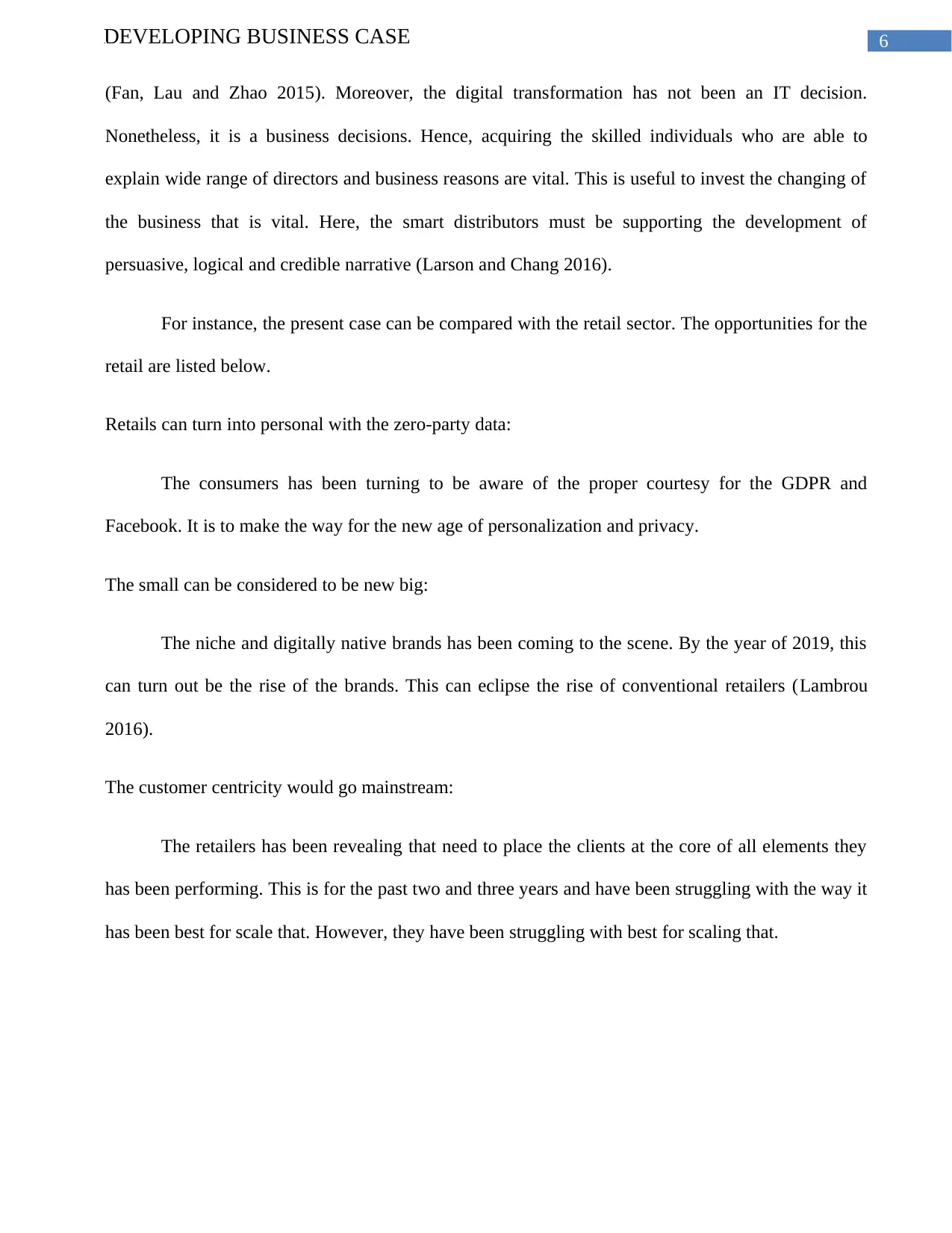
6DEVELOPING BUSINESS CASE
(Fan, Lau and Zhao 2015). Moreover, the digital transformation has not been an IT decision.
Nonetheless, it is a business decisions. Hence, acquiring the skilled individuals who are able to
explain wide range of directors and business reasons are vital. This is useful to invest the changing of
the business that is vital. Here, the smart distributors must be supporting the development of
persuasive, logical and credible narrative (Larson and Chang 2016).
For instance, the present case can be compared with the retail sector. The opportunities for the
retail are listed below.
Retails can turn into personal with the zero-party data:
The consumers has been turning to be aware of the proper courtesy for the GDPR and
Facebook. It is to make the way for the new age of personalization and privacy.
The small can be considered to be new big:
The niche and digitally native brands has been coming to the scene. By the year of 2019, this
can turn out be the rise of the brands. This can eclipse the rise of conventional retailers (Lambrou
2016).
The customer centricity would go mainstream:
The retailers has been revealing that need to place the clients at the core of all elements they
has been performing. This is for the past two and three years and have been struggling with the way it
has been best for scale that. However, they have been struggling with best for scaling that.
(Fan, Lau and Zhao 2015). Moreover, the digital transformation has not been an IT decision.
Nonetheless, it is a business decisions. Hence, acquiring the skilled individuals who are able to
explain wide range of directors and business reasons are vital. This is useful to invest the changing of
the business that is vital. Here, the smart distributors must be supporting the development of
persuasive, logical and credible narrative (Larson and Chang 2016).
For instance, the present case can be compared with the retail sector. The opportunities for the
retail are listed below.
Retails can turn into personal with the zero-party data:
The consumers has been turning to be aware of the proper courtesy for the GDPR and
Facebook. It is to make the way for the new age of personalization and privacy.
The small can be considered to be new big:
The niche and digitally native brands has been coming to the scene. By the year of 2019, this
can turn out be the rise of the brands. This can eclipse the rise of conventional retailers (Lambrou
2016).
The customer centricity would go mainstream:
The retailers has been revealing that need to place the clients at the core of all elements they
has been performing. This is for the past two and three years and have been struggling with the way it
has been best for scale that. However, they have been struggling with best for scaling that.
Paraphrase This Document
Need a fresh take? Get an instant paraphrase of this document with our AI Paraphraser
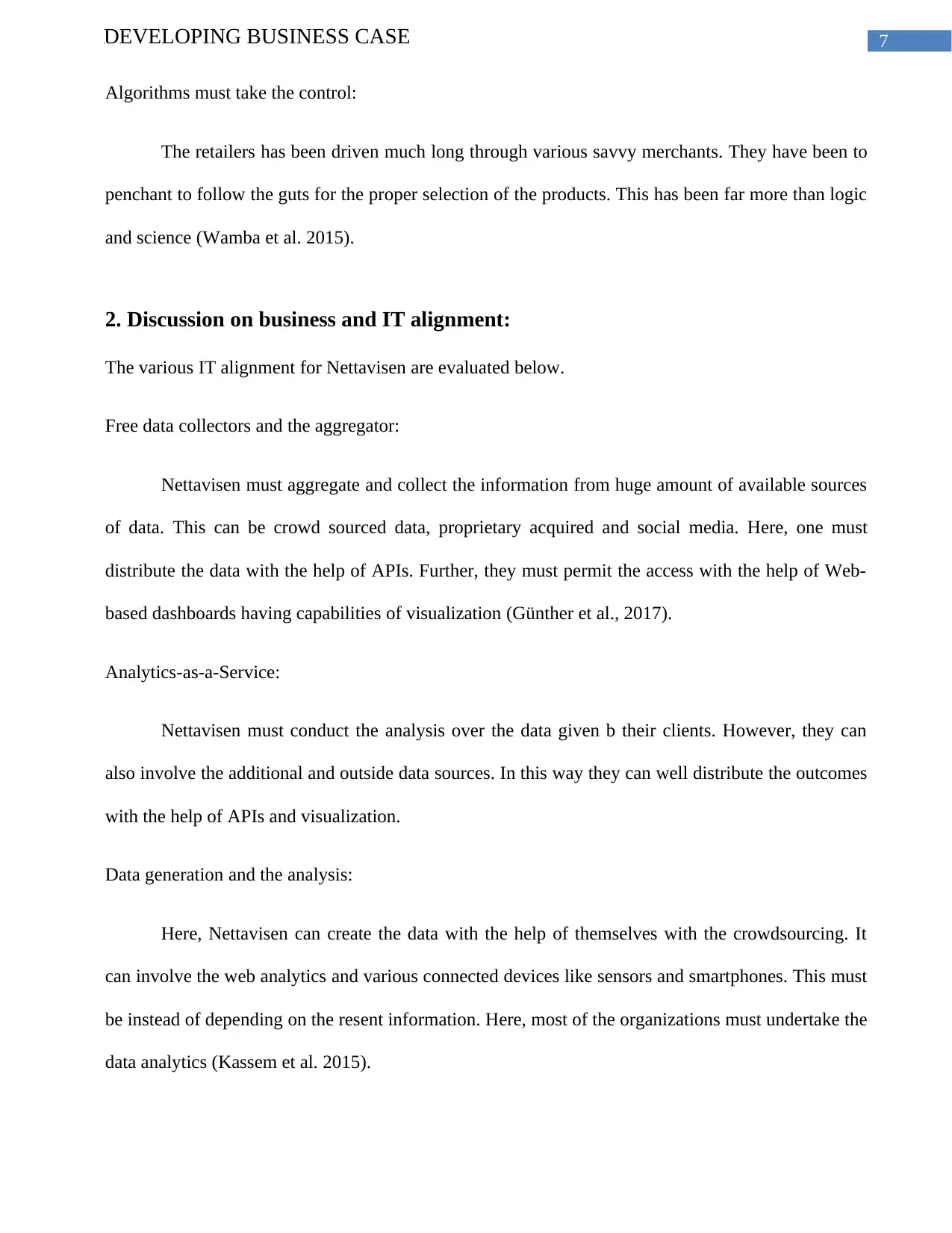
7DEVELOPING BUSINESS CASE
Algorithms must take the control:
The retailers has been driven much long through various savvy merchants. They have been to
penchant to follow the guts for the proper selection of the products. This has been far more than logic
and science (Wamba et al. 2015).
2. Discussion on business and IT alignment:
The various IT alignment for Nettavisen are evaluated below.
Free data collectors and the aggregator:
Nettavisen must aggregate and collect the information from huge amount of available sources
of data. This can be crowd sourced data, proprietary acquired and social media. Here, one must
distribute the data with the help of APIs. Further, they must permit the access with the help of Web-
based dashboards having capabilities of visualization (Günther et al., 2017).
Analytics-as-a-Service:
Nettavisen must conduct the analysis over the data given b their clients. However, they can
also involve the additional and outside data sources. In this way they can well distribute the outcomes
with the help of APIs and visualization.
Data generation and the analysis:
Here, Nettavisen can create the data with the help of themselves with the crowdsourcing. It
can involve the web analytics and various connected devices like sensors and smartphones. This must
be instead of depending on the resent information. Here, most of the organizations must undertake the
data analytics (Kassem et al. 2015).
Algorithms must take the control:
The retailers has been driven much long through various savvy merchants. They have been to
penchant to follow the guts for the proper selection of the products. This has been far more than logic
and science (Wamba et al. 2015).
2. Discussion on business and IT alignment:
The various IT alignment for Nettavisen are evaluated below.
Free data collectors and the aggregator:
Nettavisen must aggregate and collect the information from huge amount of available sources
of data. This can be crowd sourced data, proprietary acquired and social media. Here, one must
distribute the data with the help of APIs. Further, they must permit the access with the help of Web-
based dashboards having capabilities of visualization (Günther et al., 2017).
Analytics-as-a-Service:
Nettavisen must conduct the analysis over the data given b their clients. However, they can
also involve the additional and outside data sources. In this way they can well distribute the outcomes
with the help of APIs and visualization.
Data generation and the analysis:
Here, Nettavisen can create the data with the help of themselves with the crowdsourcing. It
can involve the web analytics and various connected devices like sensors and smartphones. This must
be instead of depending on the resent information. Here, most of the organizations must undertake the
data analytics (Kassem et al. 2015).
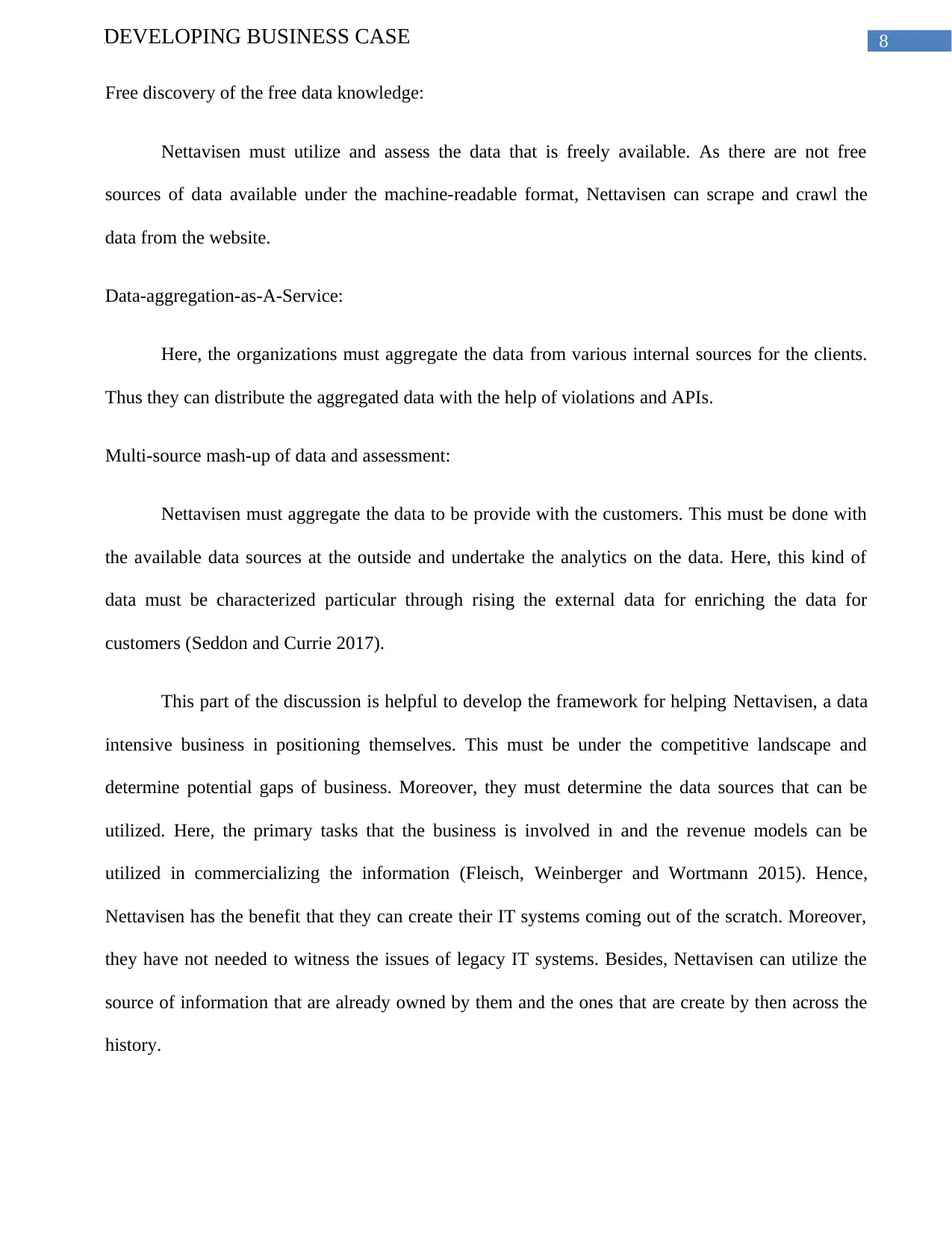
8DEVELOPING BUSINESS CASE
Free discovery of the free data knowledge:
Nettavisen must utilize and assess the data that is freely available. As there are not free
sources of data available under the machine-readable format, Nettavisen can scrape and crawl the
data from the website.
Data-aggregation-as-A-Service:
Here, the organizations must aggregate the data from various internal sources for the clients.
Thus they can distribute the aggregated data with the help of violations and APIs.
Multi-source mash-up of data and assessment:
Nettavisen must aggregate the data to be provide with the customers. This must be done with
the available data sources at the outside and undertake the analytics on the data. Here, this kind of
data must be characterized particular through rising the external data for enriching the data for
customers (Seddon and Currie 2017).
This part of the discussion is helpful to develop the framework for helping Nettavisen, a data
intensive business in positioning themselves. This must be under the competitive landscape and
determine potential gaps of business. Moreover, they must determine the data sources that can be
utilized. Here, the primary tasks that the business is involved in and the revenue models can be
utilized in commercializing the information (Fleisch, Weinberger and Wortmann 2015). Hence,
Nettavisen has the benefit that they can create their IT systems coming out of the scratch. Moreover,
they have not needed to witness the issues of legacy IT systems. Besides, Nettavisen can utilize the
source of information that are already owned by them and the ones that are create by then across the
history.
Free discovery of the free data knowledge:
Nettavisen must utilize and assess the data that is freely available. As there are not free
sources of data available under the machine-readable format, Nettavisen can scrape and crawl the
data from the website.
Data-aggregation-as-A-Service:
Here, the organizations must aggregate the data from various internal sources for the clients.
Thus they can distribute the aggregated data with the help of violations and APIs.
Multi-source mash-up of data and assessment:
Nettavisen must aggregate the data to be provide with the customers. This must be done with
the available data sources at the outside and undertake the analytics on the data. Here, this kind of
data must be characterized particular through rising the external data for enriching the data for
customers (Seddon and Currie 2017).
This part of the discussion is helpful to develop the framework for helping Nettavisen, a data
intensive business in positioning themselves. This must be under the competitive landscape and
determine potential gaps of business. Moreover, they must determine the data sources that can be
utilized. Here, the primary tasks that the business is involved in and the revenue models can be
utilized in commercializing the information (Fleisch, Weinberger and Wortmann 2015). Hence,
Nettavisen has the benefit that they can create their IT systems coming out of the scratch. Moreover,
they have not needed to witness the issues of legacy IT systems. Besides, Nettavisen can utilize the
source of information that are already owned by them and the ones that are create by then across the
history.
⊘ This is a preview!⊘
Do you want full access?
Subscribe today to unlock all pages.

Trusted by 1+ million students worldwide
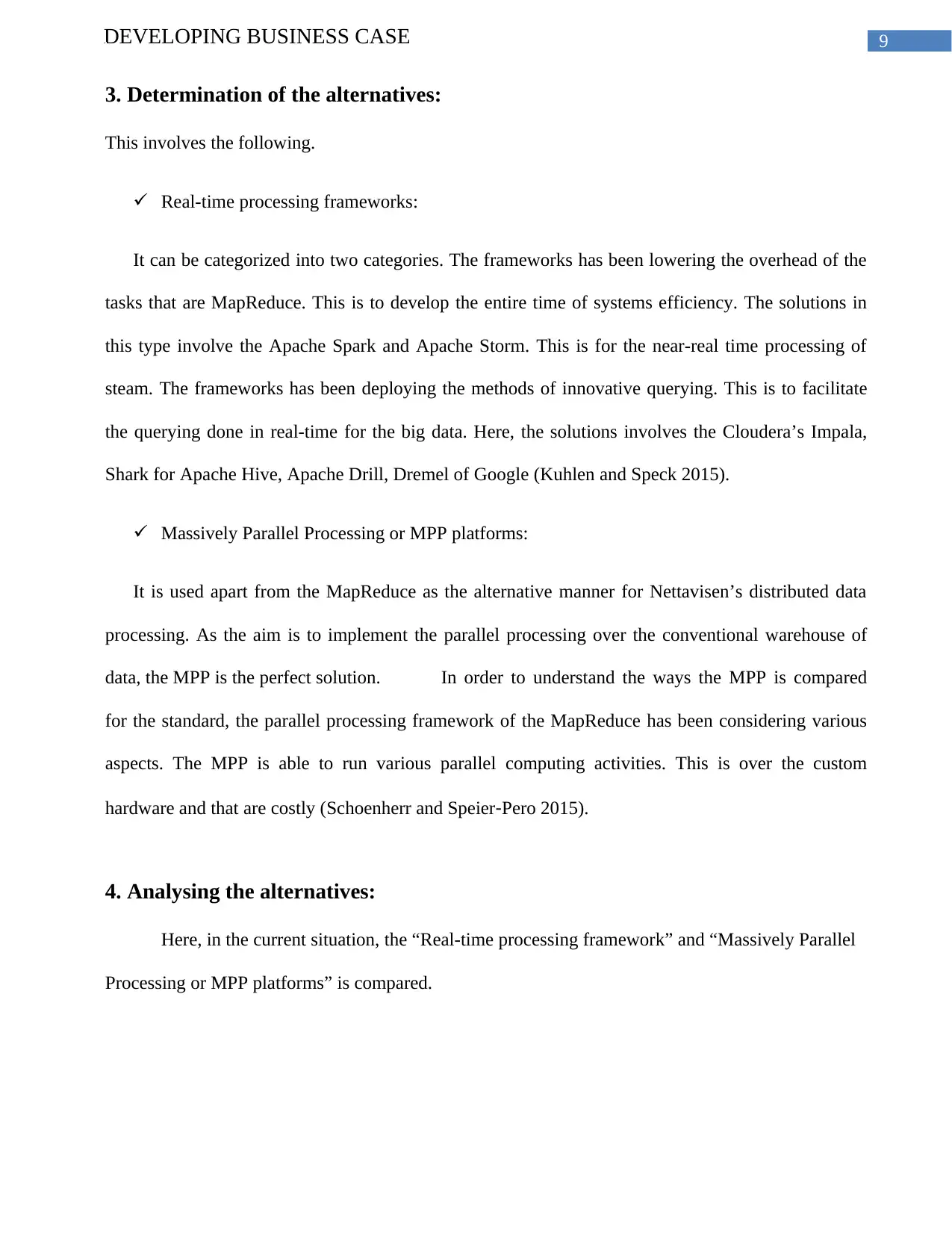
9DEVELOPING BUSINESS CASE
3. Determination of the alternatives:
This involves the following.
Real-time processing frameworks:
It can be categorized into two categories. The frameworks has been lowering the overhead of the
tasks that are MapReduce. This is to develop the entire time of systems efficiency. The solutions in
this type involve the Apache Spark and Apache Storm. This is for the near-real time processing of
steam. The frameworks has been deploying the methods of innovative querying. This is to facilitate
the querying done in real-time for the big data. Here, the solutions involves the Cloudera’s Impala,
Shark for Apache Hive, Apache Drill, Dremel of Google (Kuhlen and Speck 2015).
Massively Parallel Processing or MPP platforms:
It is used apart from the MapReduce as the alternative manner for Nettavisen’s distributed data
processing. As the aim is to implement the parallel processing over the conventional warehouse of
data, the MPP is the perfect solution. In order to understand the ways the MPP is compared
for the standard, the parallel processing framework of the MapReduce has been considering various
aspects. The MPP is able to run various parallel computing activities. This is over the custom
hardware and that are costly (Schoenherr and Speier‐Pero 2015).
4. Analysing the alternatives:
Here, in the current situation, the “Real-time processing framework” and “Massively Parallel
Processing or MPP platforms” is compared.
3. Determination of the alternatives:
This involves the following.
Real-time processing frameworks:
It can be categorized into two categories. The frameworks has been lowering the overhead of the
tasks that are MapReduce. This is to develop the entire time of systems efficiency. The solutions in
this type involve the Apache Spark and Apache Storm. This is for the near-real time processing of
steam. The frameworks has been deploying the methods of innovative querying. This is to facilitate
the querying done in real-time for the big data. Here, the solutions involves the Cloudera’s Impala,
Shark for Apache Hive, Apache Drill, Dremel of Google (Kuhlen and Speck 2015).
Massively Parallel Processing or MPP platforms:
It is used apart from the MapReduce as the alternative manner for Nettavisen’s distributed data
processing. As the aim is to implement the parallel processing over the conventional warehouse of
data, the MPP is the perfect solution. In order to understand the ways the MPP is compared
for the standard, the parallel processing framework of the MapReduce has been considering various
aspects. The MPP is able to run various parallel computing activities. This is over the custom
hardware and that are costly (Schoenherr and Speier‐Pero 2015).
4. Analysing the alternatives:
Here, in the current situation, the “Real-time processing framework” and “Massively Parallel
Processing or MPP platforms” is compared.
Paraphrase This Document
Need a fresh take? Get an instant paraphrase of this document with our AI Paraphraser
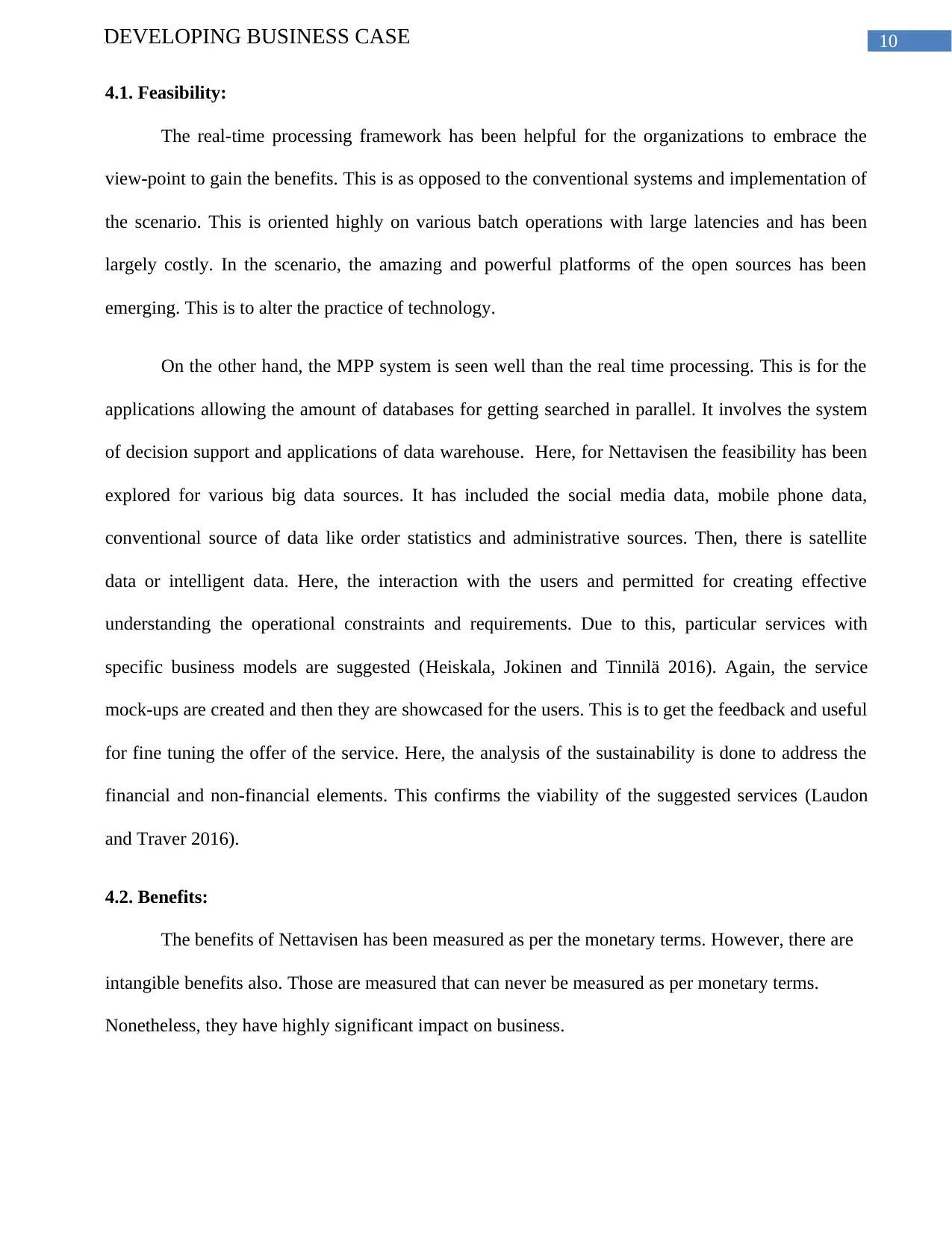
10DEVELOPING BUSINESS CASE
4.1. Feasibility:
The real-time processing framework has been helpful for the organizations to embrace the
view-point to gain the benefits. This is as opposed to the conventional systems and implementation of
the scenario. This is oriented highly on various batch operations with large latencies and has been
largely costly. In the scenario, the amazing and powerful platforms of the open sources has been
emerging. This is to alter the practice of technology.
On the other hand, the MPP system is seen well than the real time processing. This is for the
applications allowing the amount of databases for getting searched in parallel. It involves the system
of decision support and applications of data warehouse. Here, for Nettavisen the feasibility has been
explored for various big data sources. It has included the social media data, mobile phone data,
conventional source of data like order statistics and administrative sources. Then, there is satellite
data or intelligent data. Here, the interaction with the users and permitted for creating effective
understanding the operational constraints and requirements. Due to this, particular services with
specific business models are suggested (Heiskala, Jokinen and Tinnilä 2016). Again, the service
mock-ups are created and then they are showcased for the users. This is to get the feedback and useful
for fine tuning the offer of the service. Here, the analysis of the sustainability is done to address the
financial and non-financial elements. This confirms the viability of the suggested services (Laudon
and Traver 2016).
4.2. Benefits:
The benefits of Nettavisen has been measured as per the monetary terms. However, there are
intangible benefits also. Those are measured that can never be measured as per monetary terms.
Nonetheless, they have highly significant impact on business.
4.1. Feasibility:
The real-time processing framework has been helpful for the organizations to embrace the
view-point to gain the benefits. This is as opposed to the conventional systems and implementation of
the scenario. This is oriented highly on various batch operations with large latencies and has been
largely costly. In the scenario, the amazing and powerful platforms of the open sources has been
emerging. This is to alter the practice of technology.
On the other hand, the MPP system is seen well than the real time processing. This is for the
applications allowing the amount of databases for getting searched in parallel. It involves the system
of decision support and applications of data warehouse. Here, for Nettavisen the feasibility has been
explored for various big data sources. It has included the social media data, mobile phone data,
conventional source of data like order statistics and administrative sources. Then, there is satellite
data or intelligent data. Here, the interaction with the users and permitted for creating effective
understanding the operational constraints and requirements. Due to this, particular services with
specific business models are suggested (Heiskala, Jokinen and Tinnilä 2016). Again, the service
mock-ups are created and then they are showcased for the users. This is to get the feedback and useful
for fine tuning the offer of the service. Here, the analysis of the sustainability is done to address the
financial and non-financial elements. This confirms the viability of the suggested services (Laudon
and Traver 2016).
4.2. Benefits:
The benefits of Nettavisen has been measured as per the monetary terms. However, there are
intangible benefits also. Those are measured that can never be measured as per monetary terms.
Nonetheless, they have highly significant impact on business.
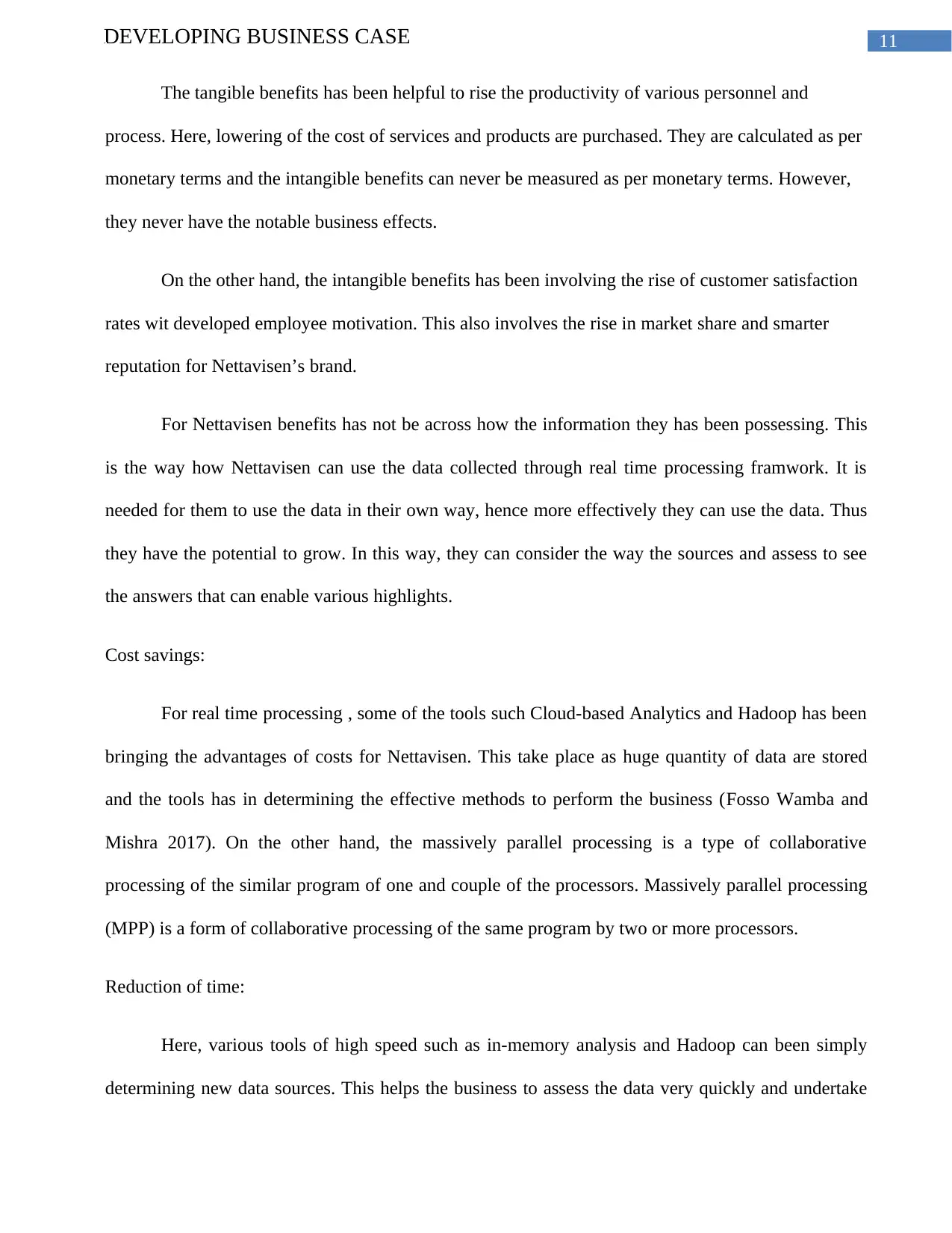
11DEVELOPING BUSINESS CASE
The tangible benefits has been helpful to rise the productivity of various personnel and
process. Here, lowering of the cost of services and products are purchased. They are calculated as per
monetary terms and the intangible benefits can never be measured as per monetary terms. However,
they never have the notable business effects.
On the other hand, the intangible benefits has been involving the rise of customer satisfaction
rates wit developed employee motivation. This also involves the rise in market share and smarter
reputation for Nettavisen’s brand.
For Nettavisen benefits has not be across how the information they has been possessing. This
is the way how Nettavisen can use the data collected through real time processing framwork. It is
needed for them to use the data in their own way, hence more effectively they can use the data. Thus
they have the potential to grow. In this way, they can consider the way the sources and assess to see
the answers that can enable various highlights.
Cost savings:
For real time processing , some of the tools such Cloud-based Analytics and Hadoop has been
bringing the advantages of costs for Nettavisen. This take place as huge quantity of data are stored
and the tools has in determining the effective methods to perform the business (Fosso Wamba and
Mishra 2017). On the other hand, the massively parallel processing is a type of collaborative
processing of the similar program of one and couple of the processors. Massively parallel processing
(MPP) is a form of collaborative processing of the same program by two or more processors.
Reduction of time:
Here, various tools of high speed such as in-memory analysis and Hadoop can been simply
determining new data sources. This helps the business to assess the data very quickly and undertake
The tangible benefits has been helpful to rise the productivity of various personnel and
process. Here, lowering of the cost of services and products are purchased. They are calculated as per
monetary terms and the intangible benefits can never be measured as per monetary terms. However,
they never have the notable business effects.
On the other hand, the intangible benefits has been involving the rise of customer satisfaction
rates wit developed employee motivation. This also involves the rise in market share and smarter
reputation for Nettavisen’s brand.
For Nettavisen benefits has not be across how the information they has been possessing. This
is the way how Nettavisen can use the data collected through real time processing framwork. It is
needed for them to use the data in their own way, hence more effectively they can use the data. Thus
they have the potential to grow. In this way, they can consider the way the sources and assess to see
the answers that can enable various highlights.
Cost savings:
For real time processing , some of the tools such Cloud-based Analytics and Hadoop has been
bringing the advantages of costs for Nettavisen. This take place as huge quantity of data are stored
and the tools has in determining the effective methods to perform the business (Fosso Wamba and
Mishra 2017). On the other hand, the massively parallel processing is a type of collaborative
processing of the similar program of one and couple of the processors. Massively parallel processing
(MPP) is a form of collaborative processing of the same program by two or more processors.
Reduction of time:
Here, various tools of high speed such as in-memory analysis and Hadoop can been simply
determining new data sources. This helps the business to assess the data very quickly and undertake
⊘ This is a preview!⊘
Do you want full access?
Subscribe today to unlock all pages.

Trusted by 1+ million students worldwide
1 out of 28
Related Documents
Your All-in-One AI-Powered Toolkit for Academic Success.
+13062052269
info@desklib.com
Available 24*7 on WhatsApp / Email
![[object Object]](/_next/static/media/star-bottom.7253800d.svg)
Unlock your academic potential
Copyright © 2020–2025 A2Z Services. All Rights Reserved. Developed and managed by ZUCOL.




